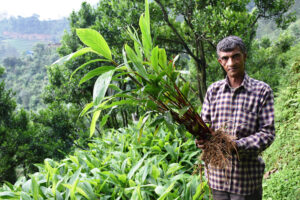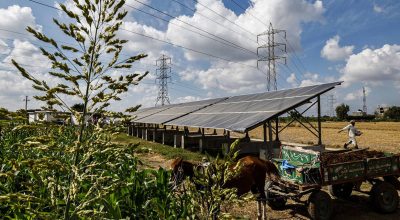
XINING, China (AP) — There’s a building boom on the Tibetan plateau, one of the world’s last remote places. Mountains long crowned by garlands of fluttering prayer flags are newly topped with sprawling steel power lines. At night, the illuminated signs of Sinopec gas stations cast a red glow over newly built highways.
Ringed by the world’s tallest mountain ranges, the region long known as “the rooftop of the world” is now in the crosshairs of China’s latest modernization push, marked by multiplying skyscrapers and expanding high-speed rail lines.
But there’s a difference: This time, the Chinese government wants to set limits on the region’s growth in order to implement its own version of one of the U.S.’s proudest legacies — a national park system.
In August, policymakers and scientists from China, the United States and other countries convened in Xining, capital of the country’s Qinghai province, to discuss China’s plans to create a unified system with clear standards for limiting development and protecting ecosystems.
Zhu Chunquan, the China representative of the International Union for the Conservation of Nature, a Switzerland-based scientific group, notes that the country’s economy has boomed over the past 40 years. But priorities are now expanding to include conserving the country’s key natural resources.
“It’s quite urgent as soon as possible to identify the places, the ecosystems and other natural features” to protect, Zhu says.
Among other goals, China aims to build Its own Yellowstone on the Tibetan plateau.
Zhu serves on an advisory committee providing input on the development of China’s nascent national park system, expected to be officially unveiled in 2020. Chinese officials also have visited U.S. national parks, including Yellowstone and Yosemite, and sought input from varied organizations, including the Chicago-based Paulson Institute and the Nature Conservancy.
The ambition to create a unified park system represents “a new and serious effort to safeguard China’s biodiversity and natural heritage,” Duke University ecologist Stuart Pimm says.
One of the first pilot parks will be in Qinghai, a vast region in western China abutting Tibet and sharing much of its cultural legacy. The area also is home to such iconic and threatened species as the snow leopard and Chinese mountain cat, and encompasses the headwaters of three of Asia’s great waterways: the Yangtze, Yellow and Mekong rivers.
“This is one of the most special regions in China, in the world,” says Lu Zhi, a Peking University conservation biologist who has worked in Qinghai for two decades.
While construction continues at a frenzied pace elsewhere on the Tibetan plateau, the government already has stopped issuing mining and hydropower permits in this region.
But a key question looms over the project: Can China marry the goals of conservation and tourism, while safeguarding the livelihoods and culture of the approximately 128,000 people who live within or near the park’s boundaries, many of them Tibetan?
“China has a dense population and a long history,” Zhu says. “One of the unique features of China’s national parks is that they have local people living either inside or nearby.”
Yellowstone is widely considered the world’s first national park. After it was created in 1872, the U.S. government forced the Native Americans who lived in the area to resettle outside the park boundaries, in keeping with 19th-century notions of wilderness protection. But countries that establish park systems in the 21st century now must consider how best to include local populations in their planning.
China has previously undertaken vast resettlement programs to clear land for large infrastructure projects such as Three Gorges Dam, which left many farmers in new homes without suitable agricultural fields or access to other livelihoods.
But in developing the national parks, the government is giving conservation-related jobs to at least a swath of people living in the Qinghai pilot park — called Sanjiangyuan — to stay and work on their land. The “One Family, One Ranger” program hires one person per family for 1,800 yuan a month ($255) to perform such tasks as collecting trash and monitoring for poaching.
Kunchok Jangtse is a Tibetan herder who earns money cleaning up rubbish through the program. He has an additional volunteer position installing and maintaining motion-activated camera traps, which help scientists monitor endangered species in Qinghai.
“Our religion is connected with wild animals, because wild animals have a consciousness and can feel love and compassion,” he says.
From his main work raising livestock and collecting caterpillar fungus for folk medicines, Kunchok Jangtse says he can make about 20,000 yuan ($2,830) annually. He is grateful for the additional income from the ranger program, but hopes his main livelihood won’t be impeded — and that he won’t eventually be forced to leave.
“I’m not a highly educated person, and I am very concerned it may bring many difficulties in my life if I would switch my job and move to another place,” he says.
The creation of protected areas is not a new idea in China. In fact, roughly 15% of the country’s land already is assigned to a bewildering patchwork of local and regional parks. But many existing reserves are simply parks on paper, run by various agencies without enforceable guidelines.
In contrast, the national parks system is being designed from the ground-up to incorporate global best practices and new science.
Ouyang Zhiyun, deputy director at the Chinese Academy of Science’s Research Center for Eco-Environmental Sciences, was the lead scientist for a recent sweeping “national ecosystems assessment” that used 20,000 satellite images and 100,000 field surveys to examine how China’s land changed between 2000 and 2010.
Now Ouyang is drawing upon that work to map priority areas for conservation and advise park planners, focusing on habitats of endangered species that live only in China.
“If we lose it here, it’s gone,” he says.
The first parks to be formally incorporated into China’s national park system will showcase the country’s vast and varied landscapes and ecosystems — from the granite and sandstone cliffs of Wuyishan in eastern China to the lush forests of southwestern Sichuan province, home to giant pandas, to the boreal forests of northeastern China, where endangered Siberian tigers roam.
When it comes to ecology, few countries have more to lose, or to save, than China.
“A huge country like China literally determines the fate of species,” says Duke University’s Pimm.















